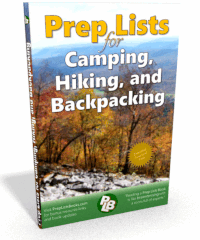A section in Chapter 2 of the book:
Prep Lists for Camping, Hiking, and Backpacking
Using water evaporation in a still—whether commercial or improvised, is best for making drinkable water from the worst sources, like the following.
- Sea water
- Polluted water
- Industrial runoff water
- Urine
Heat is needed to increase the rate of evaporation. This heat may come from the sun (solar), from a fire (wood, stove, etc.), or any other heat source. The heat can just be warm enough to encourage evaporation, or hot enough to create steam. Plan ahead by packing several lightweight turkey-sized oven bags.
Stills can be created in a number of ways. Each has the following basic components.
- A container of unclean water
- A heat source to accelerate evaporation or create steam
- A means to capture evaporated water
- A clean collection container
Consider the following ideas to distill unsafe water and make it drinkable.
Bottle Trough Still
Cut bottom off of a clean, plastic bottle—the larger the better. Roll up the bottom edge so that it curls inward, creating a trough around the inside, about an inch deep. If needed, use heat from a flame to help mold the plastic. Place this still, with cap in place, over something wet and in direct sunlight. If needed, use string to suspend this still over unclean water that is being heated. As evaporation (or steam) rises and condenses on the sides of the bottle, it will collect in the trough. To drink, twist off the cap and drink like any water bottle. Repeat as needed.
Hourglass Bottle Still
Fill a water bottle one-third full of unpurified water. Tape another bottle to this bottle at the mouth, so that together they look like an hourglass. Please these bottles in direct sunlight at a slight angle so that evaporated water from the lower side can cool and collect in the upper side.
Tree Branch Transpiration
- Tightly wrap a plastic bag around a leafy tree branch (or any leafy vegetation) and let sit several hours—until evaporated water from leaves collects in the bottom of the bag.
Wide-Mouth Jar
- Position a large, clear, glass or plastic jar over a container of unclean water in a manner that allows evaporated water to collect on the inside of the large jar and trickle down into a clean collection container. You may need several of these to produce enough distilled water.
Plastic Bag
- Much like the jar described above—with some effort, you can set up a large, clear, plastic bag—with unclean water in the bottom and inflated or propped up to direct distilled water out the side.
- Multiple bags will multiply the amount of water collected.
Hole in the Ground
- Dig a large hole in the ground, about a foot deep and 3 feet wide
- Place a large container of unclean water in the hole
- Place in the center of the hole a clean collection container
- Cover the hole with a clear plastic sheet and secure around the edges with rocks or dirt
- Place a small weight in the middle of the plastic sheet so that condensation that collects on the bottom of the sheet will drip into the clean collection container.
Large Bucket, Drum, or Pool
- Place unclean water in the large container
- Place in the center of the large container a small, clean collection container, which may need to be weighed down to keep it from in position
- Cover the large container with a clear plastic sheet and secure tightly to the rim
- Place a small weight in the middle of the plastic sheet so that condensation that collects on the bottom of the sheet will drip into the clean collection container.
Capture Steam
- Prepare a place to boil water—over a stove, campfire, candle, etc.
- Using an inverted funnel-shaped device, capture steam from the boiling water into a long, clean tube that directs the steam—as it cools and condensates into distilled water, into a clean collection container.
- Alternatively, tie large leaves, bottles, sheets of metal, or panes of glass above the rising steam that will collect the cooled vapor and drip into your container.
- Additionally, you can position cloth, t-shirt, towel, sponge, etc. over the rising steam to collect the moisture. When saturated, wring them out into a container.
} } } This information is in the book “Prep Lists for Camping, Hiking, and Backpacking.” { { {


You must log in to post a comment. Log in now.